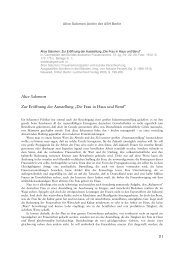Teaching Gender in Social Work - MailChimp
Teaching Gender in Social Work - MailChimp
Teaching Gender in Social Work - MailChimp
Create successful ePaper yourself
Turn your PDF publications into a flip-book with our unique Google optimized e-Paper software.
symptoms that a man must recognise to avoid an unfortunate bride. Arnsek<br />
claims that the character and the human soul are best reflected <strong>in</strong> the eyes,<br />
face and the body. Pathology and illness can therefore be recognised on the<br />
surface of women’s faces. He stresses that “strongly developed, bony cheeks, <strong>in</strong><br />
particular the lower jaw, <strong>in</strong> relation to the skull, <strong>in</strong>dicate a lack <strong>in</strong> a woman’s<br />
spiritual life.” 19 He also gives some more obvious examples: “Red rimmed eyes,<br />
with frequent <strong>in</strong>flammation and hypersensitivity to light <strong>in</strong>dicate scrofula, a<br />
chronic <strong>in</strong>flammation thought to cause trachoma or the ‘Egyptian disease’,<br />
which can lead to bl<strong>in</strong>dness if not cured; short-sightedness, farsightedness,<br />
<strong>in</strong>nate curved mouth, distorted gait, curved writ<strong>in</strong>g (now to the left, now to<br />
the right and now upright) shows a distorted, <strong>in</strong>consistent, cunn<strong>in</strong>g, capricious<br />
m<strong>in</strong>d and a character full of <strong>in</strong>ner contradictions.” 20<br />
<strong>Teach<strong>in</strong>g</strong> questions<br />
Several western researchers have shown how hysteria was socially constructed and<br />
used as an <strong>in</strong>strument for the subjugation of women. Not much is known about<br />
these issues from the perspective of the Central and Eastern European countries<br />
and beyond. Today gender-specific behaviour cont<strong>in</strong>ues to affect diagnosis but <strong>in</strong><br />
different ways. Even today, some mental health diagnoses are prevalent among<br />
girls and women and some among boys and men.<br />
1. What are the prevalent mental health diagnoses for girls and<br />
women and for boys and men <strong>in</strong> your local context? How may<br />
one expla<strong>in</strong> their gendered dimensions?<br />
Diagnosis as Part of <strong>Gender</strong> Politics<br />
For most of Central Europe the f<strong>in</strong>al decades of the n<strong>in</strong>eteenth century were<br />
marked by major social changes related to <strong>in</strong>dustrialisation and urban modernisation<br />
<strong>in</strong> the region. 21 Such huge shifts necessitated a major re-exam<strong>in</strong>ation<br />
of women’s economic, social and symbolic status <strong>in</strong> these chang<strong>in</strong>g societies.<br />
From the end of the eighteenth century a political demand of workers’ unions<br />
19<br />
Ibid.<br />
20<br />
Ibid.<br />
21<br />
See Susan Zimmermann, “Frauenbestrebungen und Frauenbewegung <strong>in</strong> Ungarn,” <strong>in</strong> Szerep es alkotas, ed. Beata<br />
Nagy and Margit Sardi. (Budapest: Csokonai Kiado, 1997), 171–204.<br />
114














